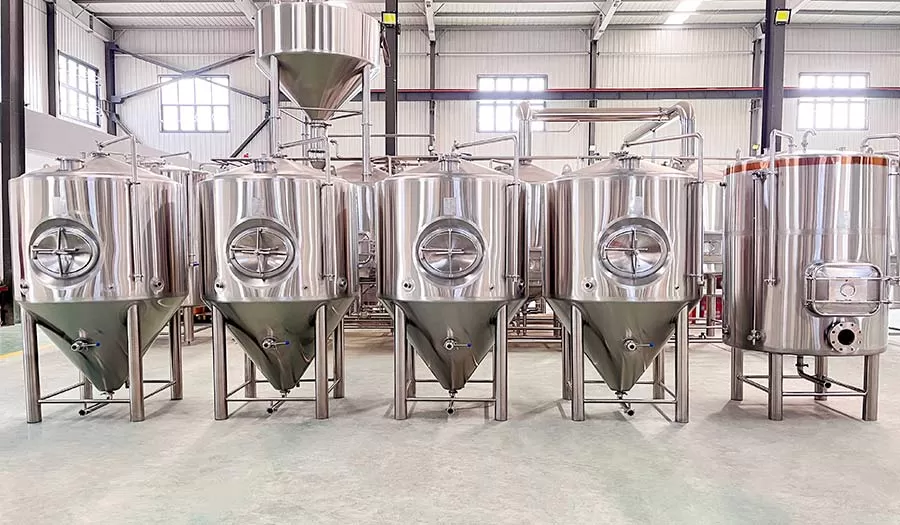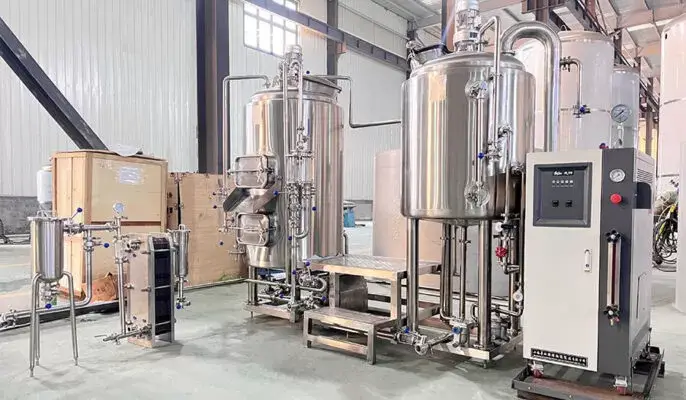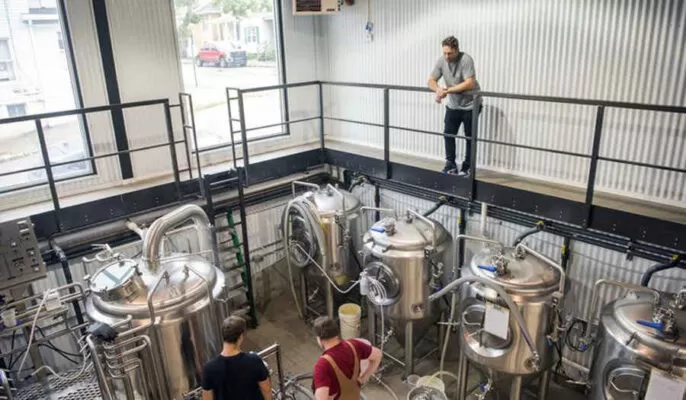IL miglior fermentatore conico è un recipiente specializzato utilizzato nel processo di fermentazione di birra, vino e altre bevande fermentate. È progettato per migliorare i processi di fermentazione e chiarificazione rispetto ai tradizionali recipienti di fermentazione come serbatoi a cielo aperto o damigiane. Sono progettati per fermentare e condizionare la birra in un unico recipiente senza giunture. I principali vantaggi dei fermentatori conici includono:
- Comoda fermentazione e condizionamento in un unico recipiente
- Il fondo a forma di cono aiuta la sedimentazione e la raccolta del lievito
- Camicie di raffreddamento integrate per il controllo della temperatura
- Capacità variabile da 3 a 30 botti
- Occhiali di ispezione e valvole di campionamento integrati
- Configurazioni completamente personalizzabili
Tipi di fermentatori conici
For homebrewers seeking to elevate their craft, the transition from simple buckets to conical fermenters is a significant leap. These specialized vessels offer superior control over fermentation, leading to clearer beers, improved flavors, and higher success rates. But navigating the diverse world of conical fermenters can seem daunting. Let’s delve into the different types, exploring their pros and cons to help you choose the perfect vessel for your brewing journey.
Material Matters: Plastic vs. Stainless Steel
The two main contenders are plastic and stainless steel. Plastic fermenters are more affordable and lightweight, making them ideal for beginners. However, they can be prone to scratches, harboring bacteria, and may struggle with temperature control. Stainless steel, on the other hand, boasts durability, ease of cleaning, and superior temperature control. They are the preferred choice for serious brewers and those fermenting larger batches, but come at a steeper price point.
Forma e dimensione: trovare il punto giusto
Conical fermenters come in various sizes, typically measured in gallons or liters. It’s crucial to choose a size that fits your batch size and fermentation space. Remember, leaving headspace for CO2 is crucial. Beyond size, the cone shape itself is key. It allows sediment to settle at the bottom, facilitating easier racking and clearer beer. Some fermenters boast steeper cones, enabling even more efficient separation.
Jacketed vs. Unjacketed: Temperature Precision
For those seeking ultimate control over fermentation temperature, jacketed fermenters are the answer. These vessels feature a double wall through which a coolant like glycol circulates, allowing precise temperature regulation. This is especially beneficial for lagers and other styles requiring strict temperature control. However, jacketed fermenters are significantly more expensive and require additional equipment like a chiller.
Campi da gioco a pressione: esplorazione delle opzioni avanzate
Some advanced conical fermenters are pressure-rated, allowing you to ferment under pressure. This can improve carbonation, suppress oxidation, and create certain beer styles like kölsch. However, pressure fermentation requires additional safety measures and specialized equipment, making it more suitable for experienced brewers.
Oltre le nozioni di base: funzionalità aggiuntive
Many conical fermenters offer additional features to enhance your brewing experience. Sample ports allow for easy gravity readings without disturbing the fermentation, while sight glasses offer a peek at the fermenting wort. CIP ports facilitate cleaning, and spunding valves regulate pressure fermentation.
Choosing the right conical fermenter is an exciting step in your brewing journey. Consider your budget, batch size, desired level of control, and brewing aspirations. With a little research and this guide as your compass, you’ll be well on your way to crafting exceptional beers in your very own conical wonderland.
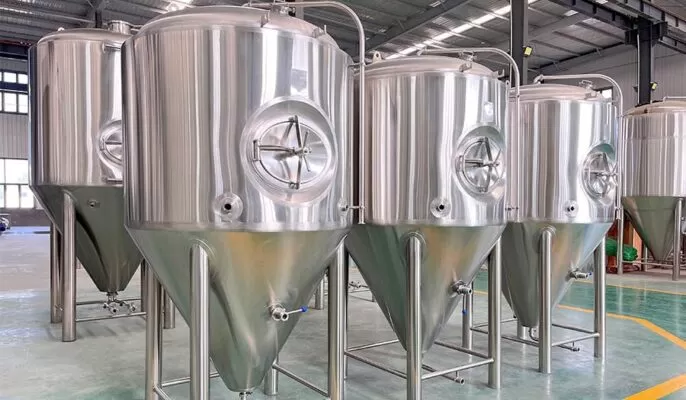
Come funzionano i fermentatori conici
For homebrewers and professionals alike, conical fermenters are more than just fancy vessels. They represent a leap towards cleaner, tastier beers, achieved through the magic of their unique design. But how exactly do these cone-shaped wonders work their fermentation magic? Buckle up, beer enthusiasts, as we delve into the science behind the cone.
First, let’s address the star of the show: the cone itself. Unlike their cylindrical counterparts, conical fermenters feature a narrow bottom that tapers down. This seemingly simple design plays a crucial role in managing yeast and sediment, the unsung heroes of fermentation. As yeast munches on sugars, it produces alcohol and CO2, happily floating around in the fermenting wort. Meanwhile, spent yeast cells and other byproducts, collectively known as trub, settle due to gravity. The cone shape guides this trub towards the narrow bottom, creating a distinct separation between the clear beer above and the sediment below.
This separation is key to several benefits. Firstly, it minimizes the beer’s exposure to the trub, which can impart off-flavors. Secondly, it allows for easier “racking,” the process of transferring the clear beer without disturbing the sediment. Traditional methods often involve siphoning, a delicate dance that risks stirring up the trub and clouding the beer. With conical fermenters, simply open a valve at the bottom to drain the trub, leaving behind crystal-clear liquid gold.
But the magic doesn’t stop there. The cone also facilitates cleaner secondary fermentation, if desired. Some brewers transfer their beer to a separate vessel for this stage, but conical fermenters eliminate this need. Since the trub is already neatly collected below, you can simply add priming sugar for carbonation directly to the fermenter, saving time and minimizing the risk of oxidation.
Beyond convenience, conical fermenters offer advantages for specific brewing styles. Lagers, for example, require precise temperature control. Some conical fermenters feature double walls that allow for the circulation of coolant, ensuring a stable fermentation environment for these delicate brews. Additionally, pressure-rated conical fermenters enable brewers to experiment with styles like kölsch, where fermentation occurs under controlled pressure.
However, it’s not all sunshine and roses. Conical fermenters require more cleaning and sanitization compared to simpler vessels due to their nooks and crannies. They also tend to be more expensive, especially stainless steel models.
Scegliere il Il miglior fermentatore conico
Quando si seleziona un fermentatore conico, i fattori chiave da considerare includono:
Table 2: Conical Fermenter Selection Guidelines
| Parametro | Dettagli |
|---|---|
| Dimensioni e capacità | Adatta alle dimensioni dei lotti e agli obiettivi di produzione |
| Dimensioni | Considerare i limiti di altezza e ingombro |
| Sistema di raffreddamento | Indispensabile per lager e controllo della temperatura |
| I materiali | Gradi di acciaio inossidabile, tipi di plastica pro/contro |
| Bilancio | Ampia gamma dalle costruzioni fai da te alle costruzioni commerciali chiavi in mano |
| Personalizzazione | Modularità per soddisfare esigenze uniche |
| Certificazioni | UL, ASME per la sicurezza commerciale |
Fornitori affidabili come Ss Brewtech, Spike Brewing, Blichmann ecc. offrono grande personalizzazione nelle loro linee coniche. Modifica coperchi, porte, valvole, raccordi, gambe, ecc. per creare il tuo recipiente di fermentazione ideale.
Table 3: Conical Fermenter Suppliers and Price Ranges
| Fornitore | Fascia di prezzo |
|---|---|
| Ss Brewtech | $800-$4000 |
| Birra Spike | $900-$2500 |
| Blichmann | $1500-$2500 |
| Re del barile | $300-$800 |
| Kegco | $250-$1500 |
Installazione, funzionamento e manutenzione
Una corretta installazione è vitale per la sicurezza e la funzionalità. La maggior parte dei conici richiede una base robusta o un supporto per sostenere saldamente il pesante recipiente in acciaio inossidabile.
Table 4: Conical Fermenter Installation Guidelines
| Considerazione | Dettagli |
|---|---|
| Superficie portante | Pavimento in cemento armato, non legno o piastrelle |
| Livellamento | Utilizzare degli spessori sotto le gambe del supporto per evitare oscillazioni |
| Ventilazione | Non racchiudere, lasciare spazio in testa per lo scarico |
| Impianti idraulici | Valvole a sfera per controllo flusso, camlock/TC per travasi |
| Elettrico | Se raffreddato, fornire un'alimentazione elettrica adeguata |
L'operazione consiste nella pulizia/disinfezione, riempimento con mosto, fermentazione, trasferimento della birra e pulizia. I conici consentono trasferimenti chiusi per ridurre al minimo l'esposizione all'ossigeno. La manutenzione prevede la sostituzione annuale di guarnizioni, parti lubrificanti e passivazione degli interni in acciaio inossidabile.
Come selezionare il giusto fornitore di fermentatori conici
Purchasing a conical fermenter is a significant investment, both financially and for your brewing journey. With a plethora of suppliers jostling for your attention, selecting the right one can feel like navigating a complex maze. Fear not, intrepid brewer! This guide will equip you with the knowledge to find a supplier who aligns with your needs and brewing aspirations.
Understanding Your Needs:
Before embarking on your quest, take a moment to introspect. What kind of brewer are you? A casual hobbyist, a passionate experimenter, or an aspiring professional? This introspection will guide your feature and budget considerations. For example, a casual brewer might prioritize affordability and simplicity, while a serious one might seek advanced features like jacketed walls or pressure capabilities.
Researching Reputable Suppliers:
Armed with self-awareness, dive into the world of conical fermenter suppliers. Online forums, brewing communities, and industry publications are invaluable resources for recommendations and supplier reviews. Be wary of overly promotional content and prioritize independent testimonials. Pay attention to factors like:
- Company history and reputation: Look for established companies with a proven track record of quality and customer service.
- Product diversity: Does the supplier offer a variety of fermenters phù hợp với your needs and budget?
- Material options: Do they offer the material you desire, be it plastic, stainless steel, or something more specialized?
- Additional features: Do they cater to your specific needs, such as jacketed walls, pressure ratings, or specific fittings?
- Warranty and support: Does the supplier offer a comprehensive warranty and readily available customer support?
Engaging with the Supplier:
Don’t hesitate to contact the suppliers directly. Ask questions about their products, warranties, and support services. Gauge their responsiveness and professionalism. A reliable supplier will be happy to answer your questions and demonstrate their expertise.
Beyond the Basics:
While price and features are crucial, consider additional factors. Does the supplier offer easy ordering and payment options? Are they geographically convenient for shipping or potential returns? Do they participate in industry events or brewing communities, demonstrating their commitment to the craft?
Making the Final Choice:
Ultimately, the right supplier is the one who inspires confidence and resonates with your brewing values. By understanding your needs, conducting thorough research, and engaging directly with suppliers, you’ll be well-equipped to choose the perfect partner for your conical fermenter journey. Remember, this is an investment in your brewing future, so choose wisely and ferment on!
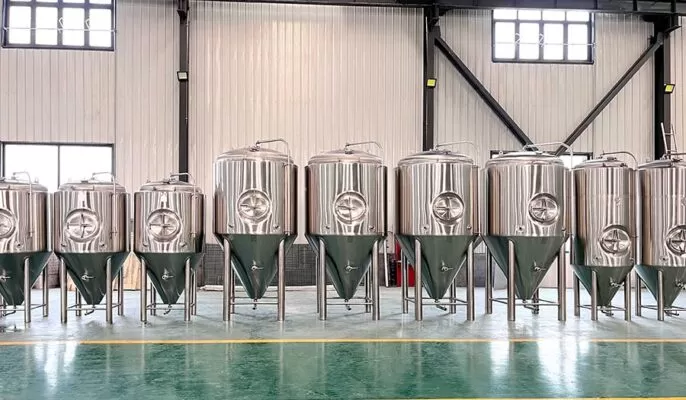
Pro e contro dei fermentatori conici
Table 6: Conical Fermenter Advantages and Disadvantages
| Pro | Contro |
|---|---|
| Raccolta efficiente del lievito | Costo iniziale caro |
| Controllo preciso della temperatura | Pesante quando è pieno, difficile da trasportare |
| Esposizione all'ossigeno ridotta al minimo | Richiedono supporti/pavimenti rinforzati |
| Vaso unico per tutti i passaggi | Capacità inferiore rispetto ai fermentatori rettangolari |
| Ingombro ridotto | I modelli orizzontali perdono spazio di testa |
| Non è necessario un serbatoio luminoso separato | Molte parti mobili richiedono manutenzione |
FAQ
Che dimensioni di fermentatore conico dovrei acquistare?
Scegli una dimensione almeno 20% più grande del volume batch target per consentire uno spazio di testa sufficiente. Per gli homebrewer, le dimensioni iniziali comuni sono quelle coniche da 7-15 galloni.
Di cosa sono fatti i fermentatori conici?
La maggior parte sono in acciaio inossidabile: grado 304 o superiore 316 per la produzione di birra. Alcuni fornitori offrono conici in polietilene di plastica come opzione economica ma hanno limitazioni sulle dimensioni.
Ne vale la pena un fermentatore conico?
Per i birrifici commerciali e gli homebrewer dedicati che cercano qualità e consistenza, i conici valgono assolutamente l'investimento rispetto ai secchi o alle damigiane. I loro vantaggi superano i maggiori costi iniziali nel tempo grazie all’efficienza e all’automazione dei processi.
Puoi condizionare la birra in un conico?
Sì, uno dei principali vantaggi dei conici è la capacità di fermentare, condizionare, carbonare e servire la birra da un unico recipiente senza travasi. Il fondo conico consente anche la raccolta rotante del lievito durante il condizionamento della birra.
Per saperne di più Attrezzature per la produzione di birra




